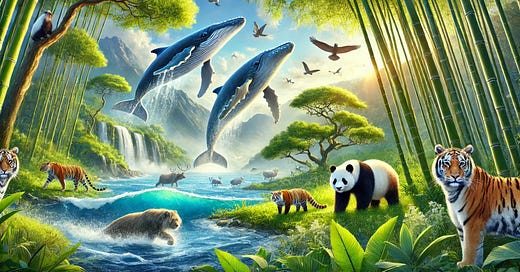Nature’s Comeback: Extraordinary Stories of Wildlife Returning From the Brink
Inspiring Tales of Species Resurgence Through Dedication and Hope
In a world often overshadowed by environmental challenges, there are still remarkable stories of triumph. Thanks to concerted conservation efforts, species once on the verge of extinction are making extraordinary comebacks.
These wildlife recovery stories prove that with dedication, collaboration, and the right policies, we can reverse the damage and foster a harmonious future where humans and wildlife coexist.
Conservation in Action: Real-Life Stories of Wildlife Recovery
Across the globe, organizations, governments, and local communities are working together to protect endangered species, yielding incredible results. These collaborative efforts demonstrate that recovery is possible when people unite for a common cause.
According to Carter Roberts, President and CEO of the World Wildlife Fund,
“Our vision is to build a future in which people and nature flourish. Early on, we focused on saving animals like rhinos and tigers from extinction.
Over time, we have come to realize how much people depend upon the natural capital in the world, and we have increasingly focused on embedding the value of nature in the decisions that governments and businesses make.”
How Global Efforts Are Saving Endangered Species
Conservation efforts have expanded globally in recent years, from grassroots campaigns to international policy changes.
Laws such as the Endangered Species Act (ESA) in the United States, protected areas, and breeding programs have played critical roles in safeguarding species from extinction.
The Road to Recovery: Species Making a Strong Comeback
Many species once at the brink of extinction are now thriving thanks to collaborative conservation efforts. Here are some inspiring examples:
Humpback Whale Recovery: Marine World Improvement
Commercial whaling drove humpback whales to the brink of extinction, with their numbers dropping to just a few thousand by the mid-20th century.
However, international bans on whaling, particularly the 1985 global moratorium by the International Whaling Commission and protections under the ESA have allowed their populations to rebound.
As of recent estimates, there are now over 80,000 humpback whales worldwide.
This recovery is a testament to the success of global cooperation and the enforcement of international treaties, proving that even large, slow-reproducing species can recover with the right protections.
Enjoying the insights? Help keep the content flowing—subscribe for free or become a paid supporter of independent journalism!
Giant Pandas: The Future Looks Brighter
The giant panda, once a symbol of wildlife under threat, has seen its population grow due to decades of conservation efforts.
The panda population has risen from just over 1,000 in the 1980s to over 1,800 today through habitat preservation and extensive breeding programs.
Although it remains vulnerable, the giant panda’s recovery symbolizes what is possible through international cooperation.
Amur Leopards: The Rarest Big Cat on Earth Makes a Comeback
With only 30 cats remaining in the wild in the early 2000s, the Amur leopard was one of the most endangered big cats on the planet.
Thanks to international conservation efforts and anti-poaching programs, the population has now grown to more than 100. This recovery illustrates the importance of cross-border collaboration to protect endangered species.
How These Success Stories Can Inspire More Conservation Efforts
Wildlife comebacks are more than just feel-good stories—they represent critical victories in the broader fight to preserve global biodiversity.
As famed primatologist Jane Goodall once said, “What you do makes a difference, and you have to decide what kind of difference you want to make.”
These successes also show that conservation is not just about saving individual species—it’s about ensuring the long-term health of ecosystems.
The recovery of species like the bald eagle, giant panda, and Amur leopard demonstrates that, with persistence, funding, and collaboration, we can protect the natural world for future generations.
Conclusion
The stories of species recovering from the brink of extinction offer a rare ray of hope in an often troubling environmental landscape.
They remind us that we can make a positive impact by taking a committed approach. From the soaring bald eagles to the resilient giant pandas, these victories prove that human actions can and do make a difference.





